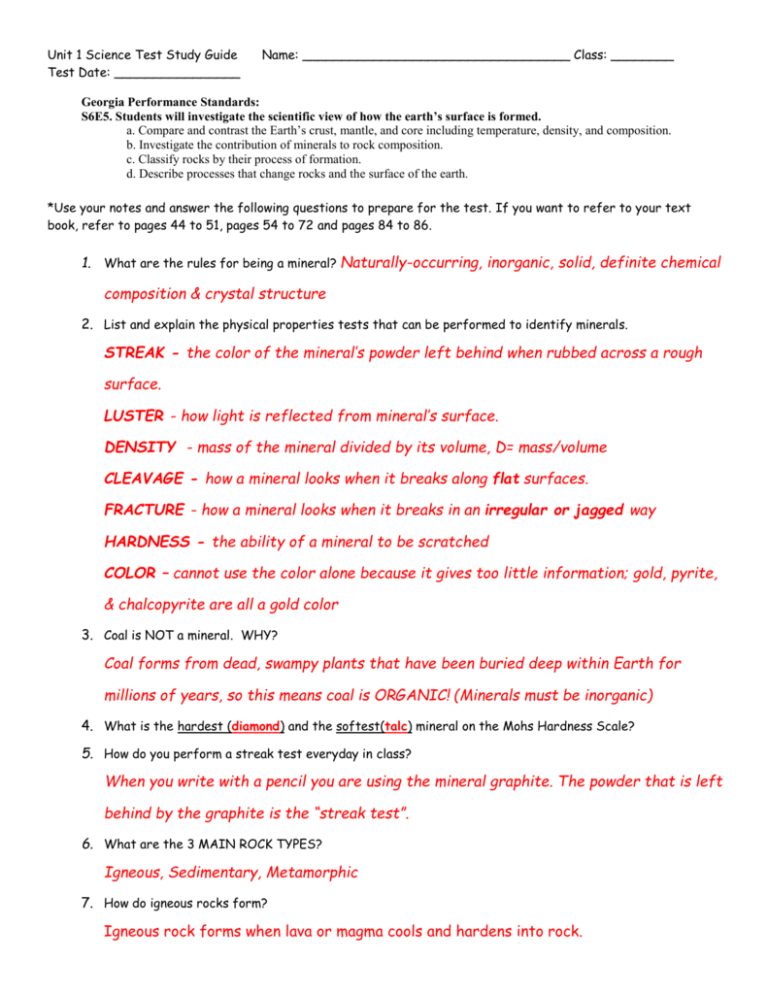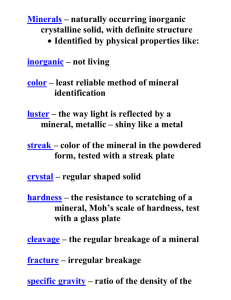Rocks and Minerals Study Guide
advertisement

Unit 1 Science Test Study Guide Test Date: ________________ Name: __________________________________ Class: ________ Georgia Performance Standards: S6E5. Students will investigate the scientific view of how the earth’s surface is formed. a. Compare and contrast the Earth’s crust, mantle, and core including temperature, density, and composition. b. Investigate the contribution of minerals to rock composition. c. Classify rocks by their process of formation. d. Describe processes that change rocks and the surface of the earth. *Use your notes and answer the following questions to prepare for the test. If you want to refer to your text book, refer to pages 44 to 51, pages 54 to 72 and pages 84 to 86. 1. What are the rules for being a mineral? Naturally-occurring, inorganic, solid, definite chemical composition & crystal structure 2. List and explain the physical properties tests that can be performed to identify minerals. STREAK - the color of the mineral’s powder left behind when rubbed across a rough surface. LUSTER - how light is reflected from mineral’s surface. DENSITY - mass of the mineral divided by its volume, D= mass/volume CLEAVAGE - how a mineral looks when it breaks along flat surfaces. FRACTURE - how a mineral looks when it breaks in an irregular or jagged way HARDNESS - the ability of a mineral to be scratched COLOR – cannot use the color alone because it gives too little information; gold, pyrite, & chalcopyrite are all a gold color 3. Coal is NOT a mineral. WHY? Coal forms from dead, swampy plants that have been buried deep within Earth for millions of years, so this means coal is ORGANIC! (Minerals must be inorganic) 4. What is the hardest (diamond) and the softest(talc) mineral on the Mohs Hardness Scale? 5. How do you perform a streak test everyday in class? When you write with a pencil you are using the mineral graphite. The powder that is left behind by the graphite is the “streak test”. 6. What are the 3 MAIN ROCK TYPES? Igneous, Sedimentary, Metamorphic 7. How do igneous rocks form? Igneous rock forms when lava or magma cools and hardens into rock. 8. How are igneous rocks classified? Igneous rocks are classified by origin, texture & mineral composition. 9. What are the 2 types of igneous rock and how do each form? Intrusive Igneous Rock forms when magma cools and hardens under Earth’s surface. Extrusive Igneous Rock forms when lava erupted from a volcano, cools and hardens on Earth’s surface. 10. What is the difference between magma and lava? Magma is molten (melted) material inside Earth. Lava is molten material that has erupted from a volcano. 11. Name a common intrusive igneous rock that formed the core of many mountain ranges. Granite 12. Name a common extrusive igneous rock that makes up most of the ocean floor. Basalt 13. Name an igneous rock that is black & glass-like and was once used by Native Americans as a cutting/scraping tool. Obsidian 14. How does silica content affect the color of igneous rock? Low silica = mostly dark colored rocks High silica = mostly light colored rocks 15. Name the igneous rock that is used for many kitchen countertops. Granite 16. Which igneous rock do people use for cleaning and scraping? (You may see this rock if you get a pedicure.) Pumice 17. Define sediments: Sediments are small broken pieces of rock or living things such as twigs, leaves, or bones. 18. What are the four steps (processes) that create sedimentary rock from sediments? Explain each one. Erosion – the movement of sediments by forces such as water and wind from one place to another Deposition – Sediments settle out of the water or wind carrying them & sink to the bottom of a lake or ocean Compaction – Process that presses sediments together. Thick layers of sediment build up over time & weigh down the layers compacting the sediments. Cementation - Dissolved minerals seep into spaces between particles (sediments) & then crystallize as they harden 19. How are sedimentary rocks classified? Sedimentary rocks are classified by the types of sediment that make up the rocks. 20. What are the 3 types of sedimentary rock? Explain each one. Clastic Sedimentary Rocks are made from rock fragments that are squeezed together. Organic Sedimentary Rocks forms where the remains of plants & animals are deposited in thick layers. Chemical Sedimentary Rocks forms when minerals that are dissolved in a solution crystallize or minerals are left behind after evaporation. 21. What are fossils, and why are they found only in sedimentary rock? Fossils are the remains of once-living things. As the plant or animal dies, it may be covered by layers of sediment. After millions of years, a fossil may form. Igneous rock form from magma or lava and they would destroy the animal. Metamorphic rock forms from heat and pressure and both heat and pressure would destroy or crush the animal. 22. What are two common uses of sedimentary rock? Flint – Arrowheads long ago Sandstone – building materials like for The White House Limestone - used as blocks & slabs for buildings, making cement & steel 23. How is metamorphic rock formed? Metamorphic rocks form from the heat & pressure deep inside Earth. 24. How are metamorphic rocks classified? METAMORPHIC ROCKS are classified according to the arrangement of the grains that make up the rock & the minerals in them. 25. What are the 2 types of metamorphic rock? What makes them different? Foliated (grains line up in parallel layers; striped or banded) Nonfoliated (random no layers arrangement of grains) 26. What famous monument in Washington, D.C. is made from metamorphic rock? Lincoln Memorial Which specific metamorphic rock is it? Marble 27. Put the following layers of earth in the correct order from outermost to innermost (inner core, crust, mantle, outer core) crust, mantle, outer core, inner core 28. Draw & label the layers of the Earth: 29. Of the 4 layers, which layer of the Earth is the thinnest? Crust Which layer is the thickest? mantle 30. Which layer has the highest temperature? Inner core 31. Why do we say that the temperature range of the crust begins with the air temperature instead of assigning it a specific temperature? The temperature is different depending on where you are on Earth, so the temperature of the crust will be different. It is not the same temperature everywhere on Earth at the same time. 32. Turn the paper over and draw a Venn Diagram or table. Label one side inner core and the other side outer core. Label the center BOTH. Compare & contrast the similarities & difference between the 2 layers. What are they made of? What state of matter are they in? Include special features. Outer Core Liquid Metal Creates Earth’s magnetic field Both Fe & Ni (Metal) Inner Core Solid Metal Ball Hottest Layer inside Earth Essay Questions: Essay #1: Show your understanding of the ROCK CYCLE. Draw and explain the steps of the rock cycle starting with an Igneous Rock. Explain each step or process that could change the rock into the other two types of rock and back into an igneous rock by following only the outer loop of the diagram. You should have at least five sentences. YOU HAVE THIS DRAWING IN YOUR NOTES. Just write the sentences. Essay #2: Show your understanding of rock formation. An animal dies and millions of years pass. Which type of rock could you likely find evidence of the fossil from that animal and why? Be sure to explain why the fossil could not be found in the other two types of rock. Include an illustration.







